Top 5 Mindful Parenting Techniques to Stay Present Every Day

Discover how mindful parenting helps you connect deeply with your child—even in a fast-paced, chaotic world. Simple tips to be more present every day.
The Gift of Presence in Parenting – More Than Just Being There
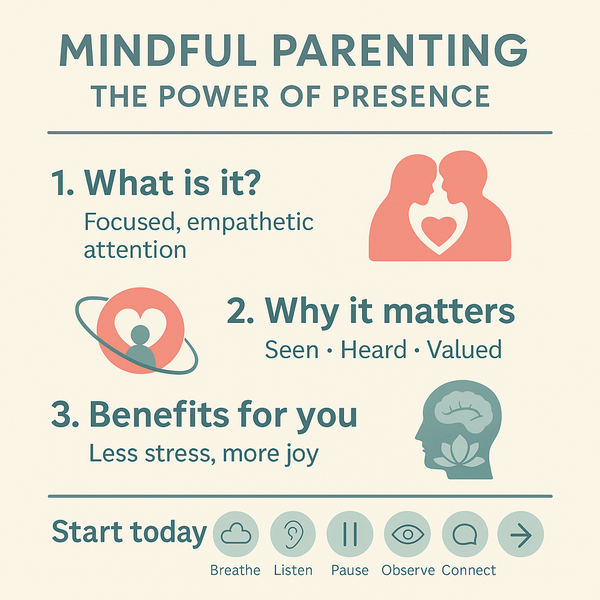
In the whirlwind of modern family life, it's easy to be physically present with children but mentally miles away, caught up in to-do lists, work pressures, or the endless scroll of a smartphone. Mindful parenting offers a different path. It’s about bringing full, open-hearted attention to a child and to the act of parenting, moment by moment, without a script or a scorecard. This approach isn't about achieving an unattainable standard of parental perfection; rather, it's about becoming an aware parent—one who embraces imperfection and consciously chooses intentional responses over knee-jerk reactions.
Jon Kabat-Zinn, a key figure in bringing mindfulness to the mainstream, defines mindfulness as "the awareness that arises through paying attention on purpose, in the present moment, and nonjudgmentally". When applied to the parent-child dynamic, mindful parenting means being "emotionally present, calm, authentic, and free, ready to grow and learn from parenting challenges".
But why make the effort to cultivate this presence in an already hectic world? The magic of staying present is transformative. In a culture often characterized by disconnection on multiple levels, mindful presence serves as a powerful countermeasure, fostering genuine connection where it matters most. Research increasingly supports the idea that this way of parenting can lower family stress, strengthen parent-child bonds, and significantly support healthy emotional development in children. Studies indicate that children who receive responsive, present care tend to grow into more confident and cooperative individuals. For parents, the journey into mindfulness can mean less reactivity, a greater sense of calm, and a more profound sense of fulfillment in their role.
The current societal landscape often pulls individuals in countless directions, fostering a state of being constantly "on" yet rarely truly "present." This pervasive sense of disconnection highlighted by some observers can inadvertently lead to a lack of parental presence, which in turn may contribute to reactive parenting styles—characterized by ordering, threatening, or punishing. Such reactions, born out of stress or distraction, model coercive behavior rather than the respectful cooperation parents typically hope to instill. Mindful parenting, by its very definition, emphasizes intentional presence and non-judgmental awareness. Consequently, adopting mindful parenting techniques directly addresses this tendency towards disconnection. It equips parents with the tools to be more present and less reactive, thereby consciously fostering a micro-culture of connection and respect within their families. This shift can have far-reaching positive effects on children's ability to form healthy relationships and navigate the complexities of the world, as children raised in such environments are more likely to develop secure attachment, better emotional regulation, and a greater capacity for cooperation
Top 5 Mindful Parenting Techniques to Stay Present Every Day
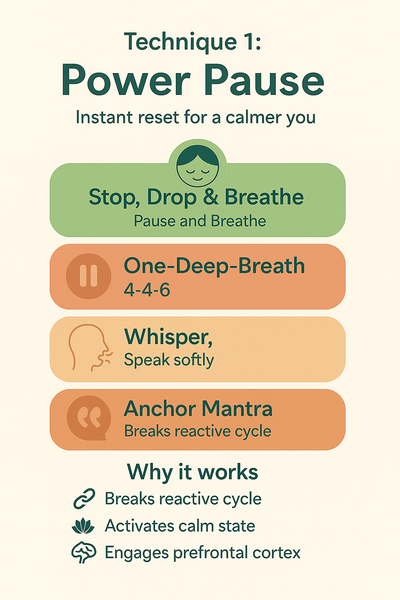
Technique 1: The Power Pause – Your Instant Reset Button for a Calmer You
The Power Pause is a brief, intentional stop taken during the day, particularly when feeling overwhelmed, triggered, or on the verge of an impulsive reaction. Its purpose is to interrupt autopilot responses and create an opportunity to choose a more mindful, thoughtful way forward.
- How to do it:
- Stop, Drop, and Breathe: When frustration levels rise or an impulsive reaction is imminent, consciously stop the current activity. Momentarily drop the immediate agenda, regardless of its perceived urgency. Take a slow, deep breath in through the nose, perhaps counting to five, and then release the breath just as slowly. Repeating this twice can be very effective. This simple action can signal the nervous system to relax, providing a crucial moment to decide on a more considered response rather than a knee-jerk one.
- The One-Deep-Breath Trick: Even a single, conscious breath can serve as a mini-reset. A common technique involves inhaling for four seconds, holding the breath for another four seconds, and then exhaling for six seconds. This can be practiced anytime, anywhere, offering an immediate anchor.
- Whisper, Don't Yell: If anger starts to bubble up, try whispering instead of raising the voice. It is surprisingly difficult to maintain a high level of anger or sound genuinely furious while whispering. This practical approach can help de-escalate personal emotional intensity.
- Adopt a Mantra: Prepare a short, calming phrase to use in challenging moments. Examples include "This too shall pass," "Relax, release, smile" , or "It doesn't have to be perfect. It just has to be enough". Repeating such a mantra can provide a grounding effect.
- Why it works: The Power Pause is effective because it breaks the cycle of reactive parenting by creating a vital space between a trigger and the subsequent response. Deep breathing, a core component of this technique, activates the parasympathetic nervous system, which promotes a state of calm and reduces the body's physiological stress response. This allows for a shift from emotional reactivity to a more thoughtful, intentional state of mind.
the power of family meals connect nourish and thrive together )The power of family meals connect nourish and thrive togetherWhy Outdoor Play is Essential for Child DevelopmentStressful parenting situations can sometimes trigger what is known as a "fight, flight, or freeze" response. This is a primitive survival mechanism, a "short route in the brain" that can bypass the prefrontal cortex—the area responsible for functions like attention and thoughtful decision-making. Techniques such as pausing and breathing are consistently recommended to manage this reactivity. The Power Pause acts as a deliberate interruption of this primitive stress pathway. By consciously stopping and engaging in deep breathing, parents give their prefrontal cortex a chance to "catch up" and re-engage. This is not merely about feeling calmer in the moment; it's about actively retraining the brain to respond to stress more adaptively. Over time, the consistent use of the pause can help diminish the intensity of stress-response triggers , making mindful responses feel more automatic and less effortful. This, in turn, contributes to creating a more stable and predictable emotional environment for the child.
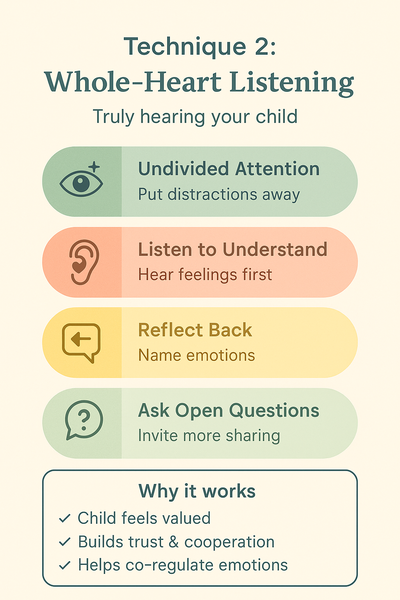
Technique 2: Listen With Your Whole Heart – Truly Hearing Your Child
Listening with your whole heart means giving a child complete, undivided attention when they are communicating. It involves focusing on understanding their words, the emotions behind them, and their underlying needs, rather than simply formulating a reply or solution.
- How to do it:
- Undivided Attention: This requires consciously putting away distractions such as phones, screens, or mental to-do lists. Making eye contact and letting the child know they have full focus, even if only for a few minutes, is key. Researchers like Duncan and colleagues emphasize "listening with full attention," which includes paying attention to "speech content, voice tone, facial expression, and body language". This act communicates to a child that they are seen, valued, and important, forming a fundamental building block for trust and connection.
- Listen to Understand, Not Just to Fix or Reply: The primary goal is to accurately grasp what the child is saying and feeling. It's important to avoid interrupting with solutions or corrections unless specifically asked. Often, the simple act of being heard is what a child needs most.
- Reflect Back: Acknowledge the child's feelings and needs through reflective listening. For example, one might say, "It sounds like you're feeling really frustrated about what happened with your toy". This demonstrates an effort to understand their perspective.
- Ask Open-Ended Questions: Encourage children to share more by asking questions that require more than a simple yes/no answer. This gives them the opportunity to provide the full context of their experience. As one source notes, "Let them finish. The process of explaining it to you can be helpful on its own".
- Why it works: This approach makes children feel heard, understood, and validated, which is crucial for their self-esteem and emotional security. It fosters a more open, honest, and cooperative parent-child relationship. Indeed, when children feel genuinely heard, they are often more likely to be cooperative. Furthermore, mindful listening helps parents understand the full emotional context of a child's behavior, enabling them to address underlying causes rather than just reacting to surface actions.
Mindful listening involves not only hearing words but also understanding emotions and acknowledging feelings. This practice often leads to more cooperative compliance from children and enhances the ability of parents and children to tackle issues as a team. Parents play a significant role in helping to regulate a child's emotions, especially during times of stress. When a parent engages in mindful listening, they are not just passively receiving information; they are actively participating in co-regulating their child's emotional state by providing a calm, understanding presence. This creates a safe space for the child to express themselves fully, which in turn allows for more effective joint problem-solving. By teaching children that their feelings will be heard and acknowledged—even if their behavior requires correction—parents equip them with better emotional regulation skills and social decision-making abilities. This models how to handle conflict constructively, a vital skill for navigating life.
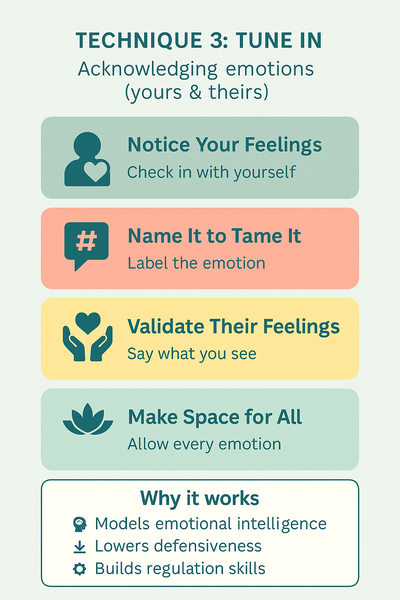
Technique 3: Tune In – Acknowledging Emotions (Yours and Theirs) Without Judgment
Tuning in involves paying close attention to and recognizing the emotions that arise in both the parent and the child. It means accepting these emotions as valid experiences without immediately trying to fix, dismiss, or judge them as "good" or "bad."
- How to do it:
- Notice Your Own Feelings: Cultivate the ability to recognize personal states like tiredness, anxiety, sadness, or irritability. Acknowledge these feelings without judgment. As one source puts it, "Mindful parenting starts with allowing yourself to sit with your feelings without judgment". Understanding one's own emotional state is crucial because it helps prevent these emotions from negatively impacting interactions with children. Being mindfully present makes it easier to acknowledge personal feelings before they escalate uncontrollably.
- "Name It to Tame It": When strong emotions surface, either in the parent or the child, try naming them. For instance, a parent might think or say, "I'm feeling frustrated right now," or to a child, "You seem really angry about that." Voicing feelings can often help to calm the emotional intensity and shift the brain into a more problem-solving mode.
- Acknowledge Your Child's Feelings: Even if the reason for a child's upset isn't immediately clear or seems disproportionate, validate their emotion. Phrases like, "I see you're very disappointed that we can't go to the park today," can be helpful. It's important to avoid dismissive comments (e.g., "Don't be such a big baby") or rushing to "fix" their feelings.
- Make Space for All Emotions: There's a common understanding that emotions pushed away or suppressed tend to grow stronger. Mindful parenting involves allowing space for the full spectrum of feelings, both pleasant and unpleasant, in oneself and in the child.
- Why it works: This practice models emotional intelligence and regulation for children. It helps parents respond to their child's needs more effectively because they gain a better understanding of the emotions driving the behavior. Non-judgmental acceptance of emotions reduces defensiveness and blaming, fostering a more open and trusting relationship. Furthermore, children tend to develop better emotional regulation skills when their own emotions are consistently acknowledged and validated by caregivers.
Mindful parenting incorporates emotional awareness of oneself and the child , non-judgmental acceptance of these emotions , and then self-regulation in how one responds. This approach stands in contrast to unmindful parenting, where parents might express their stress reactions to their children's needs. If a parent is unaware of their own emotional state—for example, feeling stressed or tired—they are more likely to react based on that internal state rather than responding to the child's actual need in that moment. By first "tuning in" to their own emotions and then to their child's, parents can better differentiate their own "stuff" from their child's experience. This clarity allows for a more authentic connection and a response that is genuinely tailored to the child's needs, rather than being a projection of the parent's unacknowledged feelings. This practice of emotional differentiation and acknowledgment is fundamental to breaking potentially unhelpful intergenerational patterns of reactive parenting. When parents model this self-awareness and emotional acceptance, children learn that emotions are manageable and not something to be feared or suppressed, which contributes to healthier emotional development and greater resilience.

Technique 4: Embrace Imperfection – The Power of Acceptance and Self-Compassion
Embracing imperfection in parenting means releasing the immense pressure to be a "perfect" parent or to raise "perfect" children. It's about meeting each moment as it is, with kindness and understanding directed towards both oneself and the child, especially when things feel challenging or go off-plan. Consider cherishing life's little moments as part of this.
- How to do it:
- Let Go of the "Perfect Parent" Myth: Life is inherently imperfect. Some days will be messy, dinner might burn, and children will inevitably act out or make mistakes. Mindful parenting involves "releasing the illusion of control and meeting each moment as it is—not as you wish it would be".
- Practice Non-Judgmental Acceptance: Strive to accept the child, their array of emotions, and their behaviors without quickly labeling them as "good" or "bad". This principle of acceptance also applies to the parent; it's important to accept personal efforts and imperfections. This creates an environment of psychological safety where mistakes are viewed as valuable learning opportunities rather than failures.
- Show Yourself Compassion: Parenting is demanding work. It's vital to acknowledge personal efforts and to avoid excessive self-criticism. Aim to treat oneself with the same kindness and understanding that would be offered to a friend facing similar challenges.
- Forgive Often: The parenting journey offers daily lessons in forgiveness—for oneself and for children. Mistakes are not endpoints but opportunities to repair relationships and reconnect. Acknowledging personal mistakes and any hurt they may have caused can be a powerful way to model taking responsibility for one's actions.
- The "Let It Be Messy" Mantra: Sometimes, the most effective approach is to simply accept the chaos. Repeating a phrase like, "It doesn't have to be perfect. It just has to be enough," can be a helpful reminder.
- Why it works: This approach significantly reduces parental stress and the risk of burnout by alleviating the pressure of unrealistic expectations. It fosters resilience in both parent and child by normalizing mistakes and shifting the focus towards growth and learning. Embracing imperfection helps build a stronger parent-child bond, one that is rooted in unconditional love and acceptance. Furthermore, self-compassion enables parents to recharge and approach ongoing challenges with renewed patience and perspective.
Several sources emphasize compassion for oneself as a cornerstone of mindful parenting. Parenting is inherently stressful , and parents are often encouraged to practice self-care and to forgive themselves for perceived shortcomings. Without a healthy dose of self-compassion, the inherent demands of mindful parenting—such as maintaining constant awareness, regulating one's emotions, and listening patiently—can paradoxically become another source of pressure and a potential yardstick for self-critique. If parents are constantly berating themselves for not being "mindful enough," they risk emotional exhaustion and burnout. Self-compassion acts as a crucial buffer, allowing parents to acknowledge their efforts, forgive their inevitable lapses, and emotionally recharge. This makes mindful parenting a sustainable, lifelong practice rather than an exhausting, unattainable ideal. When parents model self-compassion, they also teach their children an invaluable lesson: that it's okay to be imperfect and that self-kindness is an important strength. This can help protect children against developing harsh self-criticism and can foster greater emotional well-being, while also ensuring the parent remains an available and emotionally regulated caregiver.

Technique 5: Weave in Wonder – Finding Mindful Moments in the Mundane
Weaving in wonder is about intentionally bringing mindful awareness to everyday activities and routines. It’s about transforming them from mere chores or rushed transitions into opportunities for connection, presence, and even a little bit of magic.
- How to do it:
- Mindful Routines: There's no need to find extra hours in the day; mindfulness can be woven into activities already taking place.
- Meal Times: Before eating, take a moment to pause and express gratitude, perhaps for the food or for being together. Encourage noticing the colors, smells, and tastes of the food being consumed. Learn more about(The Power of Family Meals: Connect, Nourish, and Thrive Together ).
- Bedtime: Use these precious minutes to connect fully. This could be through reading a story, sharing a cuddle, or simply asking about their day, all while giving complete, focused attention. Explore tips on( The Importance of Sleep for Children's Health and Development).
- Daily Chores: While engaged in tasks like washing dishes or folding laundry, try to focus on the physical sensations—the warmth of the water, the texture of the fabric. This can turn a mundane task into a mini-meditation.
- Engage the Senses (The Five Senses Reset): When things feel overwhelming, or simply to ground oneself in the present, quickly notice: five things that can be seen, four things that can be touched, three things that can be heard, two things that can be smelled, and one thing that can be tasted. This exercise can also be shared with a child, perhaps turning a walk in the park into a sensory treasure hunt. This practice anchors individuals firmly in the present moment, pulling attention away from worries about the past or anxieties about the future.
- The Power of Play: During playtime, strive to be fully present. This means resisting the urge to check the phone or mentally run through the grocery list. Engage wholeheartedly in building Lego towers, hosting tea parties, or simply being silly together. Play is a child's primary language of connection. Discover ideas for( Why Outdoor Play is Essential for Child Development).
- Practice Gratitude: Make an intentional effort to notice the good things—moments of laughter, genuine connection, and instances of growth, however small. A simple practice before bed could involve asking the child (and oneself) to share one thing they felt grateful for that day. You can Practice Gratitude in many ways.
- Mindful Routines: There's no need to find extra hours in the day; mindfulness can be woven into activities already taking place.
- Why it works: This approach makes mindfulness accessible and eminently practical, integrating it into the very fabric of daily life rather than positioning it as another item on an already long "to-do" list. It cultivates an appreciation for small joys and everyday moments, which can enhance overall well-being and contentment. Shared mindful moments, such as engaging in playful interactions or practicing gratitude together, deepen connection and help create positive family rituals. Furthermore, engaging the senses helps both parent and child become more grounded and aware of their immediate environment and experiences.
Many suggested mindful parenting techniques focus on integrating mindfulness into existing daily activities, such as mealtimes, school drop-offs, bedtime routines , or even during caregiving tasks like diaper changes and feeding. Others involve quick resets like the "five senses" exercise. Even dedicating just ten minutes to a daily mindfulness practice is described as a "great investment". Practicing mindfulness in these small, everyday moments, even when life feels calm, helps to build a "muscle" for presence. This makes it significantly easier to access mindful awareness during more challenging or stressful situations. It can be likened to training for a marathon by undertaking shorter, regular runs; each effort builds capacity. This approach demystifies mindfulness, demonstrating that it doesn't necessarily require lengthy meditation sessions or ideal, tranquil conditions. By repeatedly bringing gentle awareness to simple, routine experiences, parents are subtly rewiring their brains for more consistent presence. This accumulated "practice" then becomes a readily available internal resource when faced with a child's tantrum or a difficult conversation, making other mindful techniques (like pausing or listening fully) easier to implement effectively. As one source notes, "the more mindful one is...the more practiced the brain becomes at maintaining calmness".
Making Mindful Parenting a Daily Habit: Progress, Not Perfection
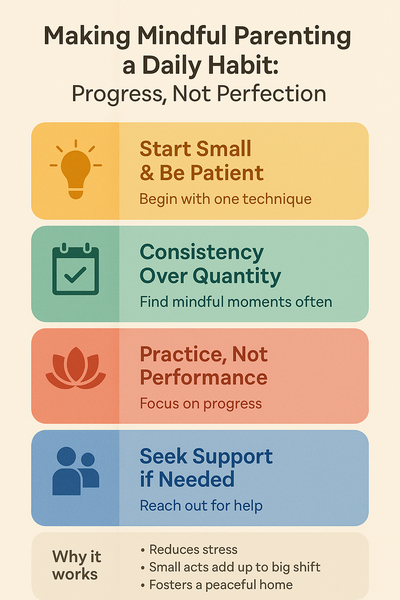
Integrating mindful parenting into daily life is a gradual process, one that flourishes with patience and consistency rather than an all-or-nothing approach. Consider these healthy parenting habits.
- Start Small and Be Patient: It's not necessary to implement all these techniques at once. Choose one technique that resonates most strongly and begin by practicing just that. It's important to remember that mindfulness, like any skill, takes time to become reliable and feel natural. Attempting to do too much too soon can lead to feelings of being overwhelmed, whereas small, consistent efforts are far more sustainable in the long run.
- Consistency Over Quantity: A few mindful moments intentionally scattered throughout the day can often be more impactful and easier to maintain than aiming for one long, infrequent session of mindfulness practice.
- It's a Practice, Not a Performance: There will inevitably be days that feel more mindful than others, and that is perfectly okay. The goal is ongoing progress and learning, not achieving a flawless performance of mindful parenting. When reactive moments happen, as they surely will, the key is to forgive oneself and gently bring awareness back to the present and the intention to be mindful.
- Seek Support if Needed: Parenting can be isolating at times. Talking to other parents, supportive family members, or professionals can be beneficial. Sharing experiences and challenges can provide new perspectives, practical strategies, and valuable emotional support. If you need to(contact ), don't hesitate.
The advice for cultivating mindful parenting often emphasizes daily practice , integration into existing routines , and the importance of patience. There's a suggestion that "mindful people have less drama in their lives, but they feel better and live longer". Each small act of mindful parenting—a deliberate pause before reacting, a moment of truly listening to a child, a compassionate self-correction after a slip-up—contributes to a larger, positive shift in the parent's internal state and, consequently, in the family's overall emotional climate. These individual moments might seem minor in isolation, but cumulatively, they work to reduce overall stress reactivity , improve emotional equilibrium , and foster healthier, more connected parent-child relationships. This highlights that mindful parenting is not about achieving a constant state of Zen-like calm, but rather about consistently planting seeds of presence, awareness, and compassion. Over time, these seeds grow and blossom, contributing to a more peaceful home environment , more cooperative children , and a more fulfilling and joyful parenting experience. The "less drama" often associated with mindful individuals is not an accidental outcome; it is the natural result of many small, intentional choices made day by day.
Conclusion: The Lasting Impact of Your Precious Presence
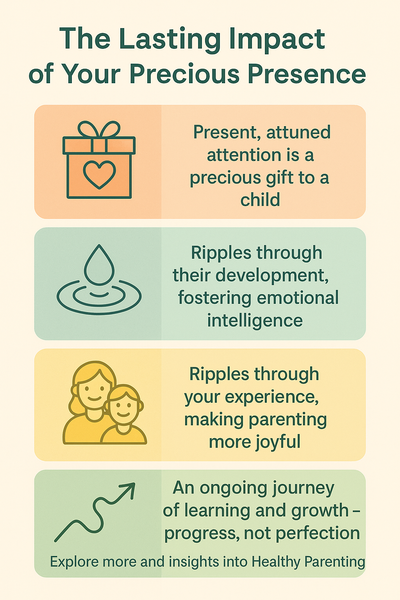
Mindful parenting is far more than a set of techniques to manage challenging behaviors; it is a profound way of being with children that nurtures their growth into building strong, confident children and emotionally intelligent individuals. The consistent gift of a parent's present, attuned awareness has a ripple effect that extends throughout a child's development and well into their future.
The presence and calm cultivated through these practices not only benefit a child's development—leading to better emotional regulation, enhanced social skills, and a deeper sense of security —but also transform the parent's own experience of raising children. It can make the journey less stressful, more connected, and ultimately, more joyful.
Embracing mindful parenting is an ongoing journey of learning and growth, a path walked alongside children. Every moment a parent chooses to be present, to listen deeply, to respond with compassion, is a precious gift—to their child, to themselves, and to the beautiful, messy, wonderful adventure of raising a human being. It is a journey where progress, not perfection, is the guiding star.
For more(parents-tips ) and insights into Healthy Parenting, explore our full(blog.
FAQs About Positive Discipline Strategies for Parents: Beyond Time-Outs
- Question:
What is mindful parenting? - Answer:
Mindful parenting is the practice of being fully present and engaged with your child in the moment. It involves listening with full attention, showing empathy, managing your own emotions, and responding thoughtfully rather than reacting impulsively. It helps foster a deeper connection and reduces stress for both parent and child. - Question:
Why is mindful parenting important? - Answer:
Mindful parenting helps create a calm and supportive environment where children feel seen, heard, and valued. It improves communication, strengthens the parent-child bond, and supports emotional regulation in both parents and kids. Being present also models healthy coping and relationship skills. - Question:
How can I practice mindful parenting in a busy schedule? - Answer:
You can incorporate mindful parenting into your routine with small actions like putting away distractions during quality time, doing a short breathing exercise together, or simply pausing to check in emotionally. Even a few minutes of focused attention can make a big difference in how connected your child feels. - Question:
What are some mindful parenting techniques I can try? - Answer:
Techniques include active listening, naming your emotions, using calming rituals, setting intentions for your day, and creating device-free time with your child. Practices like gratitude journaling or mindful walks also promote presence and connection. - Question:
Can mindful parenting help with behavioral issues? - Answer:
Yes, mindful parenting can reduce behavioral problems by helping children feel more emotionally secure and understood. When parents stay calm and respond with empathy and consistency, children are more likely to regulate their own emotions and behavior positively.
Sourced used in this blog :
Mindful Parenting in Mental Health Care - PMC - PubMed Central
The Role of Mindful Parenting in Individual and Social Decision-Making in Children
How to Be a Mindful Parent | Lion's Roar
7 Ways to Practice Mindful Parenting—and Strengthen Every Relationship
Mindful parenting: what it is, benefits & 10 ways to practice — Calm Blog
Mindfulness for parents: 5 tips to stress less and stay present — Calm Blog
Mindful Parenting: Techniques for Being Present With Your Kids
Mindful Parenting: Benefits and Strategies for Raising Kids
(PDF) A review of mindful parenting: Theory, measurement ...
Mindfulness Parenting | Psychology Today
Mindful Parenting Brings About a Peaceful Home | Psychology Today

Comments
No comments yet. Be the first to leave a comment!